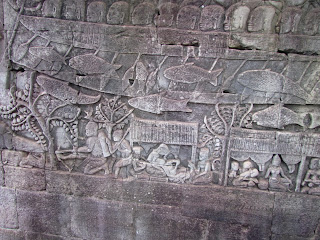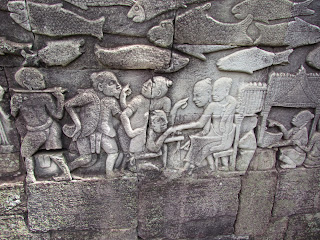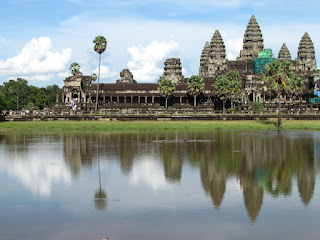I stepped out of my guesthouse door and met my motorbike driver. I hopped aboard and headed out of town. The road was potholed and quite rough. We reached the ticket area and I bought my park pass and we proceeded into the park. There was jungle all around and the trees made a tunnel of sorts that we drove through. At the end of the tunnel we exited to one of the most fantastic sights I have ever seen. There was a moat and the trees on the island inside were thin. Through the trees Angkor Wat rose in all its majesty. We drove around to the western entrance and I beheld a sight I had seen in a television documentary.
That was ten years ago. Together with my motorbike guide, we went to Angkor Wat, Angkor Thom, Ta Prohm and other temples nearby. We went to some of the middle temples on the second day. And we explored the outer temples, including Banteay Srei on the third day.
 This first day, I met up with a bunch of people who were going on a tour of the temples. There were to be 8 of us this time around. Instead of motorbikes, we were riding in tuk tuks (covered trailers attached to the back of a motorbike), and we had a guide trained on the history and structure of the temples. We headed out from the guesthouse and proceeded out of town towards the Angkor park. Where the road out of town had been in pretty rough shape ten years ago, now it was quite smooth and fairly well maintained. When we got to the ticket area, what had been a little shack with a couple of park rangers selling the park passes, was now a large structure with many lines depending on what length of park pass was being applied for. If the visitor was applying for a one day pass, they went to one line, but for a three day pass or a one week pass, they went to another area. I decided that a three day pass would be plenty, as I had already been to the park before. A camera took our photos and they were printed right on our park pass. Then we set off towards the temples. It seemed a bit sparser of trees as we went along the road. And when we reached the turn to go around Angkor Wat, the temple was not visible through the trees. On the one hand, it is good that the trees have matured and been allowed to fill in the area. On the other hand, that first glimpse of the temple is no longer there.
This first day, I met up with a bunch of people who were going on a tour of the temples. There were to be 8 of us this time around. Instead of motorbikes, we were riding in tuk tuks (covered trailers attached to the back of a motorbike), and we had a guide trained on the history and structure of the temples. We headed out from the guesthouse and proceeded out of town towards the Angkor park. Where the road out of town had been in pretty rough shape ten years ago, now it was quite smooth and fairly well maintained. When we got to the ticket area, what had been a little shack with a couple of park rangers selling the park passes, was now a large structure with many lines depending on what length of park pass was being applied for. If the visitor was applying for a one day pass, they went to one line, but for a three day pass or a one week pass, they went to another area. I decided that a three day pass would be plenty, as I had already been to the park before. A camera took our photos and they were printed right on our park pass. Then we set off towards the temples. It seemed a bit sparser of trees as we went along the road. And when we reached the turn to go around Angkor Wat, the temple was not visible through the trees. On the one hand, it is good that the trees have matured and been allowed to fill in the area. On the other hand, that first glimpse of the temple is no longer there.Our guide took us past Angkor Wat and on to Angkor Thom to begin our day. As we passed the front of Angkor Wat, I recognized the area where I ate a couple of times in the small restaurant area outside the entrance bridge to Angkor Wat. We proceeded on to Angkor Thom and reached the south entrance, the best preserved of the five entrances to the city keep. Our guide stopped us there and gave us some information about Angkor Thom. Each of the five entrances were used by different people who lived in the city. The regular people came in through the south entrance. I forget who came in through the west gate. The monks came in through the north gate. The military came in through one of the east gates. And the second east gate was used only in case of a royal death, when the remains of the royal dead were taken out and buried.
We then looked around the south entrance bridge and took photos. The bridge is bounded on either side by a group of figures holding a mythical snake called a Naga. The Naga is a seven headed snake. The figures holding the snake on the right hand side of the bridge were demons. The figures on the left hand side were gods. They were depictions on of the Hindu myths called the churning of the sea of milk. Gods and demons were fighting for control of the Earth and had a tug of war of sorts using the Naga. During the tug of war, the sea of milk was churned and produced different things, among them the three-headed elephant, the five-headed horse, and the elixir of immortality.
 And above the entrance was the four-headed statue of “Buddha,” but more likely the face of Jayavarman VII.
And above the entrance was the four-headed statue of “Buddha,” but more likely the face of Jayavarman VII.We met up again inside and our guide took us in to the Bayon. This is the temple inside Angkor Thom. It is a Buddhist temple, but it also has Hindu aspects. According to the guide, the two kinds of temple have distinctive characteristics. Hindu temples look like small mountains. They are built high. It is even better if they can be built on top a mountain. It signifies the ascent to heaven. On the other hand Buddha was more connected to the Earth. Buddhist temples are generally relatively flat and low to the ground. At the time of the Khmer empire, the kingdom was reverting back and forth between Hinduism and Buddhism. And at the time Angkor Thom itself was built, the official religion was Hinduism, but the king, Jayavarman VII was a Buddhist. So he had things built in the Hindu style, but he put in Buddhist symbols. For instance each of the stupas in the Bayon has four faces, like the stupas that will be found in a Buddhist temple. But he had it disguised by putting his own face on them. (Or maybe that was just vanity. I suppose it's hard to tell.) In any case, the Bayon is one of the locations where Tomb Raider was filmed. It is currently undergoing a lot of restoration work and there were a number of areas where we were not allowed to go. There were still plenty of areas to explore, but the restoration covers disturbed the aesthetics of the site a little bit.
 Particularly striking are all the reliefs and other carvings that are all over the Bayon temple. They are amazingly detailed and well preserved.
Particularly striking are all the reliefs and other carvings that are all over the Bayon temple. They are amazingly detailed and well preserved. Next, we headed to the king's residence. It is just an empty forest now, surrounded by a stone wall. There are two bathing pools outside, one large and one small. The large one was for the women, and the small one was for the men. The reason for the difference is that men are lazy and just jump in get themselves wet and clean the dirt off and then jump out. Women swim about, preen and such. This is what the guide said anyway.
Next, we headed to the king's residence. It is just an empty forest now, surrounded by a stone wall. There are two bathing pools outside, one large and one small. The large one was for the women, and the small one was for the men. The reason for the difference is that men are lazy and just jump in get themselves wet and clean the dirt off and then jump out. Women swim about, preen and such. This is what the guide said anyway.The palace complex was quite large and had held quite an opulent royal residence. However it was all made of wood, which has long since rotted away.
 Inside the palace complex, we headed to the Baphuon, a temple that now lies in ruins. But on the back of the Baphuon, there is a large reclining Buddha built into the temple.
Inside the palace complex, we headed to the Baphuon, a temple that now lies in ruins. But on the back of the Baphuon, there is a large reclining Buddha built into the temple.And then it was to the Terrace of the Elephants. This was a long stage area where ceremonies, plays and other public shows were held. Our guide told us that a million people lived in and around the Angkor Thom keep. The king was apparently kind and good and did much to keep his people entertained and happy. He also supposedly established a hostel system in the kingdom. Every 15 to 20 kilometers along the ancient roads of the kingdom, he had a temple and sleeping area built for when people were travelling in the empire. They could stay in the hostels for free as citizens of his domain. That sounds like a good king.
 We also passed by, but didn't really look at, the Terrace of Leper King. I was a bit disappointed. This is how tours go. Some of the things that might be of interest can be passed because of time constraints and the mood of the group. But I had explored this whole area quite well on my first visit. I also had a three day park pass. I could come back another day on my own and explore at will.
We also passed by, but didn't really look at, the Terrace of Leper King. I was a bit disappointed. This is how tours go. Some of the things that might be of interest can be passed because of time constraints and the mood of the group. But I had explored this whole area quite well on my first visit. I also had a three day park pass. I could come back another day on my own and explore at will.By this time it was getting towards noon. Our guide told us that at this point, our next destination would be quite crowded and it would be less so after lunch. So he proposed it to be lunchtime. We agreed and proceeded to a restaurant. Along the way we passed other temples in the jungle. It is still amazing to me that all this lay hidden in the jungle for hundreds of years, with only the destructive trees for company.
 Then we came out beside a man-made lake and there was so much development. There were large restaurants and places to eat. People's homes were also around. None of that had been there on my previous visit. There has been so much development since then. I suppose it's inevitable, and it wouldn't be fair to keep people from living their lives as they had on land that was theirs, but it did mar the sense of tranquillity and isolation in the jungle that existed before.
Then we came out beside a man-made lake and there was so much development. There were large restaurants and places to eat. People's homes were also around. None of that had been there on my previous visit. There has been so much development since then. I suppose it's inevitable, and it wouldn't be fair to keep people from living their lives as they had on land that was theirs, but it did mar the sense of tranquillity and isolation in the jungle that existed before.Then it was on to the Tomb Raider temple, the jungle temple, Ta Prohm. There is one aspect of Ta Prohm that has always struck me, every time I see it. Ta Prohm was particularly overrun by the jungle. And it has been left that way as other temples and structures have been freed of jungle and restored. Today there are still lots of trees sitting on the walls and temple areas. One in particular straddles a wall and its roots dangle low to the ground. It is this that drags my imagination to what it must have been like after the temples were rediscovered. The explorers wandering through the jungle, peering at what was underneath the trees that lay all over, trying to imagine how it must have looked when it was a thriving area.
 This temple also has the spot that is depicted in Tomb Raider, where Lara Croft enters the underground area of the temples. That doesn't actually exist (the underground part), but it was a movie after all.
This temple also has the spot that is depicted in Tomb Raider, where Lara Croft enters the underground area of the temples. That doesn't actually exist (the underground part), but it was a movie after all.There is no way to show all of the temple in a spot such as this, but it was amazing just wandering around the temple and looking at what was and how it came to its end.
 Our final stop for the day was Angkor Wat. As the crown jewel in the archaeological park, I had thought we would go there first and spend a while at the temple. However, I guess nowadays, there are so many people visiting that it's better to go later to avoid the huge crowds coming in on their day trips from other countries. We came in from the back. There was practically nobody there. Most of the temples were arranged in the normal pattern, facing east. The east is where the sun rises, and so represents life, wealth and much that is good in the eastern religions. Angkor Wat is different. It faces west. The sun sets in the west and so is symbolically linked with death. Angkor Wat is a tomb. So it faces west. We approached it from its eastern edge and saw the shape of it against the afternoon sun.
Our final stop for the day was Angkor Wat. As the crown jewel in the archaeological park, I had thought we would go there first and spend a while at the temple. However, I guess nowadays, there are so many people visiting that it's better to go later to avoid the huge crowds coming in on their day trips from other countries. We came in from the back. There was practically nobody there. Most of the temples were arranged in the normal pattern, facing east. The east is where the sun rises, and so represents life, wealth and much that is good in the eastern religions. Angkor Wat is different. It faces west. The sun sets in the west and so is symbolically linked with death. Angkor Wat is a tomb. So it faces west. We approached it from its eastern edge and saw the shape of it against the afternoon sun.Again, it is too big and has too many fascinating aspects to show it all here in this blog. I can only present some photos and a bit of description. We also didn't spend as much time here as we could have. It was getting late and people were getting tired and wanted to go back and rest. We didn't go to see the depiction of the Churning of the Sea of Milk, which is presented along one of the galleries on the south side. But again, I decided that if I wanted to see it again, I could come back on another day with my three day pass. I did notice that much had changed. When I first visited, visitors were allowed amazing access to all areas of the temple. I was able to climb right to the top of the structure and sit and watch the sun lower in the sky. Now there are ropes and chains all over restricting where people can go. The very top of the structure has access limited to a number of people at a time and a line to get there. I know that that is the way it must to preserve the temple for as long as possible, but I am still very glad that I came as it was still opening up and I had the access to it that I did.
After finishing with Angkor Wat, we headed back to town, a long day of seeing ancient temples finished.














































No comments:
Post a Comment